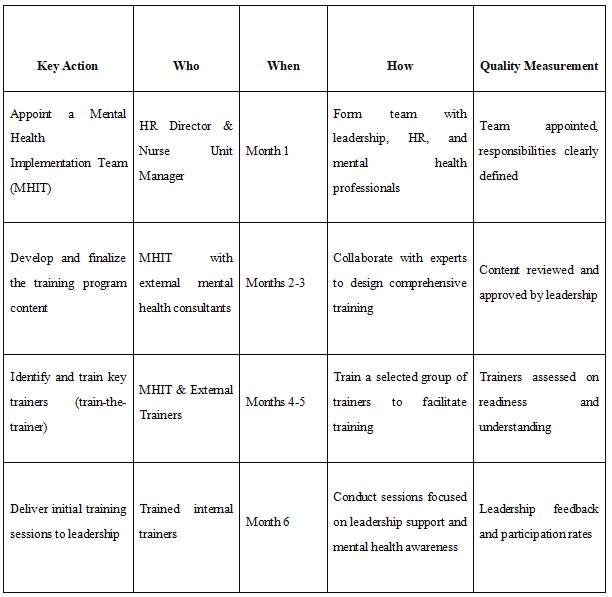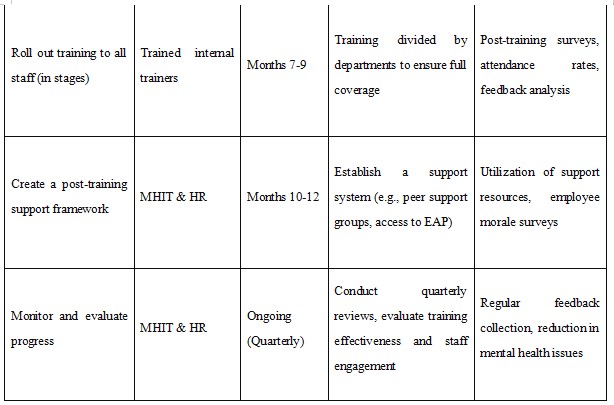Strategic Leadership for Mental Health Policy in Healthcare Settings HSM5042
- Subject Code :
HSM5042
Introduction
Building a Safe Climate for Disclosure of Health Workers' Mental Health The policy to be developed will provide a foundation to enhance openness and care for mental health in care facilities. As a Nurse Unit Manager, working alongside other health professionals, my responsibility will be to respond to any given mental health issues appropriately and confidentially. The policy was structured to minimise stigma and career-related repercussions for staff disclosing mental health challenges while creating a better workplace culture.
Findings from my Strategic Issues study appear to indicate that although there are many opportunities in the full implementation of this policy - for example, in boosting staff morale, reducing turnover, and improving patient care services - it also has attendant challenges in terms of stigma, resource reallocation, and management buy-in. Although they are adequate as-of-date, training, and awareness programs in the current capacity to answer the concerns highlighted above will add strength to the mental health support systems within the organisation. The general outcome of having this policy will be good because it addresses urgent issues regarding the well-being of the workforce and builds up organisational effectiveness. This strategy and action plan offer a general framework for effectively implementing the proposed mental health policy in the unit.
Discussion
Business Case and Recommendation
My recommendation for the policymakers is to make apolicy that "Creating a Safe Environment for Health Worker Mental Health Disclosure," three strategic options have been explored to address the key issues as well as leverage the opportunities based on the Strategic Issues study. As opined by Doe, P., Smith, L., & Wong, S. (2022), the strategies aim at providing a "Safe Environment for Health Worker Mental Health Disclosure" to create a favorable environment for disclosure from among other challenges such as stigma, limited resources, and lack of leadership buy-in. These are my strategies as a Nurse Unit Manager that developed by brainstorming and strategic analysis, factoring in capabilities, capacity, and alignment with the vision, mission, and values of the organisation (3 module 4).
Broadly categorised, strategic options are as follows:
Strategic Option 1: Mandatory Training Program for Leadership and Staff on Comprehensive Mental Health Awareness
As a Nurse Unit Manager, my first strategy is Mandatory Training Program for Leadership and Staff on Comprehensive Mental Health Awareness Programs. According to me, this is a mandatory education program for all leaders and staff regarding mental health awareness (5 Module 4). Reduce stigma and create safe environments for disclosures. This would facilitate managers' training on promoting early identification of mental health issues, open discussion with staff, and support structures such as counseling and EAPs. According to me, this would then give the two-way solution for de-stigmatization and improving responses from leadership in creating a safer environment for disclosures.
Strategic Option 2: Organization of the Mental Health Support Unit
Another important strategy Organization of the Mental Health Support Unit. I realised this option organises a special MHSU within the organisation. The organisation employs trained professionals who specialise in supporting the mental health requirements of health workers. It forms a confidential setting where health workers can discuss concerns, get counselling on issues involving their mental health, and access other mental health resources free from fear of retribution (Jones, A., & Phillips, M., 2021). This could directly address the intention given by policy: confidential support without stigma.
Strategic Option 3: Peer Support and Mentorship
The third option is to develop a peer support and mentorship program, whereby a skilled peer can offer emotional and professional support to colleagues facing mental health issues. According to my perspective, in mentorship more experienced staff guide junior staff in doing their duties, while in peer support circles, one fosters openness when discussing mental health. As elaborated by Brown, J., & Green, K. (2023), this strategy maximises the influence of the power of peer relationships in removing stigma and promoting openness.
Table 1: Inclusive Comparison of How Each OptionMeet Strategic Objectives
Budget and Timeline Overview
Table 2: Budget Table
Option 1: Assessing the strategic options, considering all factorsMandatory Training Program, Mental Health Support Unit (MHSU), and Peer Support & Mentorshipare all aligned with the organization's objectives that will help in promoting positive employee well-being, promote workplace culture as a supportive workplace that fosters productivity.
Option 1: Required Training Program Costs only $18,000 to implement and has continuing costs each year of $2,000. It has mainly dealt with preparing employees with basic mental health skills that contribute to a healthier work culture. I realised that by its implementation for six months, thus the eventual benefits derived would come about promptly so that all the goals are adequately met both in terms of welfare and productivity at the workplace.
Option 2: Mental Health Support Unit (MHSU) involves an up-front investment of $95,000 but will cost $210,000 every year, offering a comprehensive mental health resource that aligns directly with all three strategic objectives, but has a longer rollout duration at 12 months, meaning the intervention effect will be delayed.
Option 3: Peer Support & Mentorship is the least expensive at $4,000 and takes four months. However, its informal structure also may not be as effective in addressing employee overall well-being and productivity that can be fully accomplished with the other options. In the final analysis, Options 1 and 2 best align with our strategic objectives.
Recommendation
I realised that considering effectiveness, feasibility, and value alignments, the option recommended for the program is Option 1: System-wide Comprehensive Mental Health Training of the Leadership and Staff. According to me, this option is more likely to succeed in attaining policy goals, effectively managing the critical issues of stigma and leadership support, and creating a culture of openness. Also, option 2: Organisation of the Mental Health Support Unit will suit the organisational mission of building a healthy and supportive work environment and is feasible given the current resource constraints. Not only this but also my approach may be upgraded with aspects from Option 3, including peer support to make for a holistic form of mental health support useful to all parties, both staff and the organisation at large.
Implementation Action Plan
My recommended strategy to implement the "Creating a Safe Environment for Health Worker Mental Health Disclosure" policy involves enrolling leaders and staff in comprehensive mental health training (2-module 4). This participative approach will facilitate a team-based working environment among staff and leaders, working together to break down the mental health stigma, enhance support, and build a culture of openness. As a Nurse Unit Manager adopting such an approach may be more time-consuming, but it is indeed crucial to staff engagement and the long-term success of the initiative.
Table 3: Key Action Plan


Critical Overview of Key Learning
1. How: According to me the participative approach is precisely what will keep staff engaged. Engaging leaders and frontline workers ensure that trust and ownership are built in, thus enhancing the possibility of success. Furthermore, a participative approach focuses on continuous feedback and modification of strategies based on the real-time needs of the staff.
2. What: My strategy is establishing MHIT; Developing training content; and then roll-out in phases. It starts from the top-management level and cascades further downwards to staff; there must be a smooth culture change in all directions on matters of mental health support.
3. When: As a Nurse Unit Manager experience this timeline is feasible in 12 months, giving leadership and staff ample time for training and provision for ongoing monitoring and adjustment.
4. Where/Who: The management of implementation will be led by the HR Director and Nurse Unit Manager. The program would be interpreted through mental health professionals and other internal trainers to all employees throughout the organisation.
5. Quality Measurement Success will be measured by employee opinion, engagement of employees, and positive workplace mental health trend indicators, such as reductions in absenteeism and improving job satisfaction. Quarters will ensure that when improvements are required, changes are implemented.
6. Contingency: I realised that there is a likelihood of failure to achieve the program objective if the leadership or staff shows resistance based on stigma. As opined by Fischer et al. (2019), a contingency plan would include support reinforcement for the strategy from the leadership as well as revisiting the approach taken in training when appropriate. The MHIT will conduct ongoing reviews and strategize adjustments as necessary to ensure that the strategy aligns with organisational goals (4 module 4).
This would ensure the proper and collaborative roll-out of the mental health policy, thus providing an organisation with clear pathways to a mentally healthy workplace.
Conclusion & Critical Reflection on Leadership
In a nutshell, the study encompasses strategic planning, business planning, and action planning processes for creating a safe environment for healthcare workers to disclose mental health. The key issues were reviewed, and it was realised that improving the morale of staff and their turnover would be reduced when the proposed policy is implemented, and with better treatment for patients, therefore. As a Nurse Unit Manager experience the participatory training program for leadership and staff should be a strategy. The recommended strategy responds to the values of the organisation and its goals and, in the current case, puts mental health support as an integral part of the workplace culture.
From my capabilities as a leader, I realise that my current development is crucial to impacting the challenges this policy opportunity presents to my position as a Nurse Unit Manager. The role of creating a working environment where staff feel free to raise issues over mental health positions me in vulnerable situations; therefore, I must create trust and openness among the team members and ensure that my peers are well-informed about mental health issues. In preparation for this, I vowed to improve my communication and facilitation skills so that I can take on leadership of my group when necessary to push through resistance or obstacles while actively pursuing self-reflection so that I am empowering my peers and getting a sustainable system in place that works towards mental wellness. It has strengthened my belief in something that effective leadership not only thrives with flexibility but also empathy and the ability to learn of much necessity is that quality in guiding our organisation towards a healthier work environment.
Are you struggling to keep up with the demands of your academic journey? Don't worry, we've got your back!
Exam Question Bank is your trusted partner in achieving academic excellence for all kind of technical and non-technical subjects. Our comprehensive range of academic services is designed to cater to students at every level. Whether you're a high school student, a college undergraduate, or pursuing advanced studies, we have the expertise and resources to support you.
To connect with expert and ask your query click here Exam Question Bank

